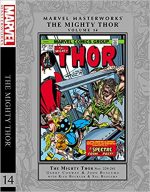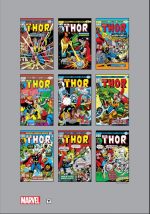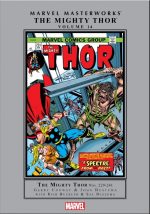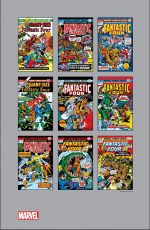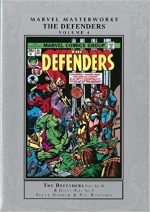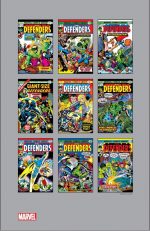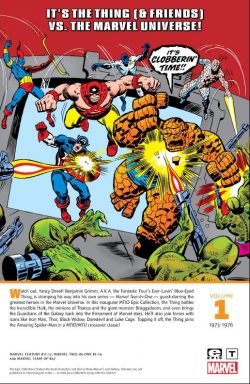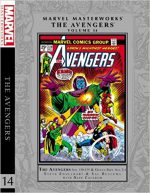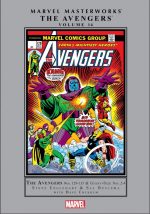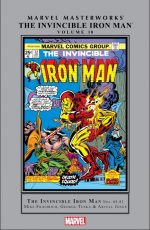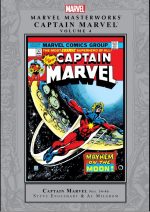
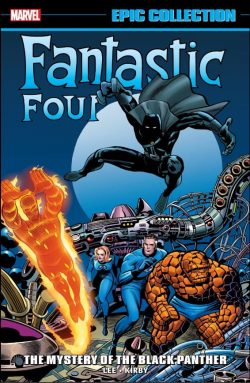
By Stan Lee & Jack Kirby with Marie Severin, Joe Sinnott, Frank Giacoia and various (Marvel)
ISBN: 978-1-3029-1556-8 (TPB)
Win’s Christmas Gift Recommendation: Epic and Groundbreaking… 10/10
Concocted by Stan Lee and Jack Kirby, with inks by George Klein & Christopher Rule, Fantastic Four #1 (bi-monthly and cover-dated November 1961) was crude, rough, passionate and uncontrolled excitement unlike anything young fans had ever seen before.
Thrill-hungry kids pounced on it and the raw storytelling caught a wave of change starting to build in America. It and succeeding issues changed comicbooks forever.
This full-colour compendium – also available as a digital download – collects issues #52-67 and Annuals #4-5, plus material from Not Brand Echh #1 & 5 (spanning July 1966 to December 1967): an astounding progression of landmark tales as Stan & Jack cannily built on that early energy to consolidate the FF as the leading title and most innovative series of the era.
As seen in the ground-breaking premier issue, maverick scientist Reed Richards, his fiancée Sue Storm, their close friend Ben Grimm and Sue’s teenaged brother survived an ill-starred private space-shot after Cosmic Rays penetrated their ship’s inadequate shielding and mutated them all.
Richards’ body became elastic, Sue gained the power to turn invisible, Johnny Storm could turn into living flame whilst tragic Ben shockingly devolved into a shambling, rocky freak. After the initial revulsion and trauma pass, they solemnly agree to use their abilities to benefit mankind and thus was born The Fantastic Four.
The FF became the indisputable central title and most consistently groundbreaking series of Marvel’s ever-unfolding web of cosmic creation: a forge for new concepts and characters at a time when Kirby was in his conceptual prime and continually unleashing his vast imagination on plot after spectacular plot whilst Lee scripted some of the most passionate superhero sagas that Marvel – or any publisher, for that matter – has ever seen.
Both were on an unstoppable roll, at the height of their creative powers, and full of the confidence that only success brings, with The King particularly eager to see how far the genre and the medium could be pushed…
Without preamble the wonderment commences with an actual social revolution as a new unforgettable character debuted. ‘The Black Panther!’ (Fantastic Four #52, cover-dated July 1966) was an enigmatic African monarch whose secretive kingdom was the only source of a vibration-absorbing alien metal. These mineral riches had enabled him to turn his country into a technological wonderland. Bold and confident, he lured the quartet into his savage super-scientific kingdom as part of an extended plan to gain vengeance on the murderer of his father. He was also the first black superhero in American comics.
After battling the team to a standstill, King T’Challa reveals his tragic origin in ‘The Way it Began..!’, which also introduces sonic super-villain Klaw. In the aftermath Johnny and his tag-along college roommate Wyatt Wingfoot embark on a quest to rescue the Torch’s Inhuman lover Crystal (imprisoned with her people behind an impenetrable energy barrier in the Himalayas). Their journey is interrupted when they discover the lost tomb of Prester John in #54’s‘Whosoever Finds the Evil Eye…!’ and almost perish in devastating, misguided combat…
After aiding the FF against world-devouring Galactus, the Silver Surfer was imprisoned on Earth by the vengeful space-god. The brooding, perpetually moralising ex-herald had quickly become a fan-favourite, and his regular appearances were always a guarantee of something special.
‘When Strikes the Silver Surfer!’ sees him in uncomprehending, brutal battle with the Thing, whose insecurities over his blind girlfriend Alicia Masters explode into searing jealousy when the gleaming skyglider comes calling, after which business as unusual resumes when ‘Klaw, the Murderous Master of Sound!’ ambushes the team in their own home in #56.
Throughout all the stories since their imprisonment, a running sub-plot with the Inhumans had been slowly building, with Johnny and Wyatt stuck on the other side of the Great Barrier: wandering the wilds and seeking a method of liberating the Hidden City.
Their quest led directly into the spectacular battle yarn ‘The Torch that Was!’: lead feature in the fourth FF Annual (November 1966) in which The Mad Thinker recovers and resurrects the original Human Torch (in actuality the world’s first android and a major star of Timely/Marvel’s Golden Age) to destroy the flaming teenager…
The blistering battle briefly reunites the entire team and leads into an epic clash with their greatest foe.
Fantastic Four #57-60 is Lee & Kirby at their very best; with unbearable tension, incredible drama and breathtaking action on a number of fronts as the most dangerous man on Earth steals the Silver Surfer’s cosmic power, even as the Inhumans finally win their freedom and we discovered the tragic secret of mighty mute Black Bolt in all its awesome fury.
It all begins with a jailbreak by the Sandman in #57’s ‘Enter… Dr. Doom!’, escalates in ‘The Dismal Dregs of Defeat!’ as Doom tests his limitless stolen power; builds to a crescendo in ‘Doomsday’ with the heroes’ utter defeat and humiliation before culminating in brains and valour saving the day – and all humanity – in truly magnificent manner in ‘The Peril and the Power!’
Even though the team had just defeated cosmically-empowered Doom and returned to the Silver Surfer his purloined life-energies, there was never a dull moment: no sooner had the heroes relaxed than a new and improved foe attacked once more in Fantastic Four #61’s ‘Where Stalks the Sandman?’.
This began another explosive multi-part tale wherein Johnny and imprisoned beloved Crystal are reunited, even as Reed is beaten in battle and lost to the anti-matter hell of the Negative Zone’s sub-space corridor…
It’s Crystal to the rescue in ‘…And One Shall Save Him!’ as amphibious guest-star Triton (of the newly liberated Inhuman Royal Family) plucks the doomed genius from the jaws of disaster and inadvertently introduces another unique enemy. This diabolical monster follows Reed back from the anti-matter universe and straight into partnership with the still-seething Sandman. The resulting battle against ‘Blastaar, the Living Bomb-Burst!’ (FF #63, June 1967) wrecks half the city before some modicum of security is restored…
Looking for a little peace and quiet, the exhausted team then tackle ‘The Sentry Sinister’: a frenetic south seas adventure romp pitting the vacationing heroes against a super-scientific automaton buried for millennia by an ancient star-faring race.
This tropical treat expanded the burgeoning interlocking landscape to an infinite degree by introducing the ancient, imperial and alien Kree who would grow into one of the fundamental pillars supporting the vast continuity of the Marvel Universe.
Although regarded on Earth as a long-dead race, the Kree themselves resurface in the very next issue as the team is targeted by an alien emissary of vengeance ‘…From Beyond this Planet Earth!’
Pitiless Ronan the Accuser has come looking to see what could possibly have destroyed an invincible Sentry – and finds out to his great regret – but whilst the fight ensues Alicia is abducted by a super scientific stranger…
The mystery of her disappearance is revealed in #66 in ‘What Lurks Behind the Beehive?’ as the outraged FF trail the seemingly helpless artisan to a man-made technological wonderland. Here a band of rogue geniuses have genetically engineered the next phase in evolution only to lose control of it even before it can be properly born…
‘When Opens the Cocoon!’ exposes the secret of the creature known as Him and only Alicia’s gentle nature is able to placate the nigh-omnipotent creature (who would eventually evolve into doom-ridden cosmic voyager Adam Warlock), after which the tight continuity pauses to allow the Inhumans (time-lost race of paranormal beings long secluded from mortal men) and Black Panther to share the stage in 1967’s Fantastic Four Annual wherein sinister invader Psycho-Manattempts to ‘Divide… and Conquer!’ the Earth.
Frank Giacoia inked this tale, with the emotion-bending micro-marauder holding both the King of Wakanda and the Royal Family of Attilan at bay until the FF can pitch in, delayed as they were by the news that the Sue Richards is pregnant… and soon to be confined in the most appallingly sexist manner until the birth…
The Annual also includes another comedy insight into the creation of Marvel Epics as Stan, Jack & Frank ask ‘This is a Plot?’ and – after the now customary Kirby pin-ups (Inhumans Black Bolt, Gorgon, Medusa, Karnak, Triton, Crystal and Maximus, a colossal group shot of Galactus, Silver Surfer and others, plus a double-page spread of the quirky quartet) – a rapidly rising star-in-the-making gets his first solo appearance.
‘The Peerless Power of the Silver Surfer’ is a pithily potent fable of ambition and ingratitude reintroducing and upgrading the threat-level of the Mad Thinker’s lethal Artificial Intelligence murder-machine Quasimodo…
Ending on a comedic note, this enticing tome includes a brace of pertinent parodies from Marvel’s spoof title Not Brand Echh, opening with (#1 August 1967) Lee, Kirby & Giacoia’s reassessment of Doom’s theft of the Power Cosmic in ‘The Silver Burper!’) and ending in a blistering boisterous bout between ‘The Ever-Loving Thung vs The Inedible Bulk!’(courtesy of Lee, Marie Severin & Giacoia).
Art lovers and history buffs can also enjoy a boundless hidden bounty at the end of this volume as we close with fascinating freebies in the form of the initial designs for Coal Tiger (who evolved into the Black Panther), Kirby & Sinnott’s unused first cover for FF #52 as well as a dozen Kirby/Sinnott original art pages.
Also on show is a pencil rough for FF #64, an alternative cover to #65 plus a previous collection cover drawn by Kirby and painted by Dean White.
Epic, revolutionary and unutterably unmissable, these are the stories which made Marvel the unassailable leaders in fantasy entertainment and which remain some of the most important superhero comics ever crafted. The verve, conceptual scope and sheer enthusiasm shines through on every page and the wonder is there for you to share. If you’ve never thrilled to these spectacular sagas then this book of marvels is the perfect key to another – far brighter – world and time.
6© 1966, 1967, 2019 MARVEL. All rights reserved.

